public ConstraintLayout getRoot() {
return this.rootView;
}
}
4. ViewBinding 与 Kotlin 委托双剑合璧
到这里,ViewBinding 的使用教程已经说完了。但是回过头看,有没有发现一些局限性呢?
- 1、创建和回收 ViewBinding 对象需要重复编写样板代码,特别是在 Fragment 中使用的案例;
- 2、binding 属性是可空的,也是可变的,使用起来不方便。
那么,有没有可优化的方案呢?我们想起了 Kotlin 属性委托,关于 Kotlin 委托机制在我之前的一篇文章里讨论过:Kotlin | 委托机制 & 原理。如果你还不太了解 Kotlin 委托,下面的内容对你会有些难度。
下面,我将带你一步步封装 ViewBinding 属性委托工具:
4.1 ViewBinding + Kotlin 委托 1.0
首先,我们梳理一下我们要委托的内容与需求,以及相应的解决办法:
| 需求 | 解决办法 |
|---|---|
| 需要委托 ViewBinding#bind() 的调用 | 反射 |
| 需要委托 binding = null 的调用 | 监听 Fragment 视图生命周期 |
| 期望 binding 属性声明为非空不可变变量 | ReadOnlyProperty<F, V> |
FragmentViewBindingPropertyV1.kt
private const val TAG = “ViewBindingProperty”
public inline fun viewBindingV1() = viewBindingV1(V::class.java)
public inline fun viewBindingV1(clazz: Class): FragmentViewBindingPropertyV1<Fragment, T> {
val bindMethod = clazz.getMethod(“bind”, View::class.java)
return FragmentViewBindingPropertyV1 {
bindMethod(null, it.requireView()) as T
}
}
/**
- @param viewBinder 创建绑定类对象
*/
class FragmentViewBindingPropertyV1<in F : Fragment, out V : ViewBinding>(
private val viewBinder: (F) -> V
) : ReadOnlyProperty<F, V> {
private var viewBinding: V? = null
@MainThread
override fun getValue(thisRef: F, property: KProperty<*>): V {
// 已经绑定,直接返回
viewBinding?.let { return it }
// Use viewLifecycleOwner.lifecycle other than lifecycle
val lifecycle = thisRef.viewLifecycleOwner.lifecycle
val viewBinding = viewBinder(thisRef)
if (lifecycle.currentState == Lifecycle.State.DESTROYED) {
Log.w(
TAG, "Access to viewBinding after Lifecycle is destroyed or hasn’t created yet. " +
“The instance of viewBinding will be not cached.”
)
// We can access to ViewBinding after Fragment.onDestroyView(), but don’t save it to prevent memory leak
} else {
lifecycle.addObserver(ClearOnDestroyLifecycleObserver())
this.viewBinding = viewBinding
}
return viewBinding
}
@MainThread
fun clear() {
viewBinding = null
}
private inner class ClearOnDestroyLifecycleObserver : LifecycleObserver {
private val mainHandler = Handler(Looper.getMainLooper())
@MainThread
@OnLifecycleEvent(Lifecycle.Event.ON_DESTROY)
fun onDestroy(owner: LifecycleOwner) {
owner.lifecycle.removeObserver(this)
mainHandler.post { clear() }
}
}
}
使用方法:
class TestFragment : Fragment(R.layout.fragment_test) {
private val binding : FragmentTestBinding by viewBindingV1()
override fun onViewCreated(root: View, savedInstanceState: Bundle?) {
binding.tvDisplay.text = “Hello World.”
}
}
干净清爽!前面提出的三个需求也都实现了,现在我为你解答细节:
-
问题 1、为什么可以使用 V::class.java,不是泛型擦除了吗? 利用了 Kotlin 内敛函数 + 实化类型参数,编译后函数体整体被复制到调用处,V::class.java 其实是 FragmentTestBinding::class.java。具体分析见:Java | 关于泛型能问的都在这里了(含Kotlin)
-
问题 2、ReadOnlyProperty<F, V> 是什么? ReadOnlyProperty 是不可变属性代理,通过 getValue(…) 方法实现委托行为。第一个类型参数 F 是属性所有者,第二个参数 V 是属性类型,因为我们在 Fragment 中定义属性,属性类型为 ViewBinding,所谓定义类型参数为 <in F : Fragment, out V : ViewBinding>;
-
问题 3、解释下 getValue(…) 方法? 直接看注释:
@MainThread
override fun getValue(thisRef: F, property: KProperty<*>): V {
1、viewBinding 不为空说明已经绑定,直接返回
viewBinding?.let { return it }
2、Fragment 视图的生命周期
val lifecycle = thisRef.viewLifecycleOwner.lifecycle
3、实例化绑定类对象
val viewBinding = viewBinder(thisRef)
if (lifecycle.currentState == Lifecycle.State.DESTROYED) {
4.1 如果视图生命周期为 DESTROYED,说明视图被销毁,此时不缓存绑定类对象(避免内存泄漏)
} else {
4.2 定义视图生命周期监听者
lifecycle.addObserver(ClearOnDestroyLifecycleObserver())
4.3 缓存绑定类对象
this.viewBinding = viewBinding
}
return viewBinding
}
- 为什么 onDestroy() 要采用 Handler#post(Message) 完成? 因为 Fragment#viewLifecycleOwner 通知生命周期事件 ON_DESTROY 的时机在 Fragment#onDestryoView 之前。
4.2 ViewBinding + Kotlin 委托 2.0
1.0 版本使用了反射,真的一定要反射吗?反射调用 bind 函数的目的就是获得一个 ViewBinding 绑定类对象,或许我们可以试试把创建对象的行为交给外部去定义,类似这样:
inline fun <F : Fragment, V : ViewBinding> viewBindingV2(
crossinline viewBinder: (View) -> V,
crossinline viewProvider: (F) -> View = Fragment::requireView
) = FragmentViewBindingPropertyV2 { fragment: F ->
viewBinder(viewProvider(fragment))
}
class FragmentViewBindingPropertyV2<in F : Fragment, out V : ViewBinding>(
private val viewBinder: (F) -> V
) : ReadOnlyProperty<F, V> {
相同 …
}
使用方法:
class TestFragment : Fragment(R.layout.fragment_test) {
private val binding by viewBindingV2(FragmentTestBinding::bind)
override fun onViewCreated(root: View, savedInstanceState: Bundle?) {
binding.tvDisplay.text = “Hello World.”
}
}
干净清爽!不使用反射也可以实现,现在我为你解答细节:
-
问题 4、(View) -> V 是什么? Kotlin 高阶函数,可以把 lambda 表达式直接作为参数传递,其中 View 是函数参数,而 T 是函数返回值。lambda 表达式本质上是 「可以作为值传递的代码块」。在老版本 Java 中,传递代码块需要使用匿名内部类实现,而使用 甚至连函数声明都不需要,可以直接传递代码块作为函数值;
-
问题 5、Fragment::requireView 是什么? 把函数 requireView() 作为参数传递。Fragment#requireView() 返回 Fragment 根视图,在 onCreateView() 之前调用 requireView() 会抛出异常;
-
问题 6、FragmentTestBinding::bind 是什么? 把函数 bind() 作为参数传递,bind 函数的参数为 View,返回值为 ViewBinding,与函数声明 (View) -> V 匹配。
4.3 ViewBinding + Kotlin 委托 最终版
2.0 版本已经完成了针对 Fragment 的属性代理,但是实际场景中只会在 Fragment 中使用 ViewBinding 吗?显然并不是,我们还有其他一些场景:
- Activity
- Fragment
- DialogFragment
- ViewGroup
- RecyclerView.ViewHolder
所以,我们有必要将委托工具适当封装得更通用些,完整代码和演示工程你可以直接下载查看:下载路径,这里只展示部分核心代码如下:
@JvmName(“viewBindingActivity”)
inline fun <A : ComponentActivity, V : ViewBinding> viewBinding(
crossinline viewBinder: (View) -> V,
crossinline viewProvider: (A) -> View = ::findRootView
): ViewBindingProperty<A, V> = ActivityViewBindingProperty { activity: A ->
viewBinder(viewProvider(activity))
}
@JvmName(“viewBindingActivity”)
inline fun <A : ComponentActivity, V : ViewBinding> viewBinding(
crossinline viewBinder: (View) -> V,
@IdRes viewBindingRootId: Int
): ViewBindingProperty<A, V> = ActivityViewBindingProperty { activity: A ->
viewBinder(activity.requireViewByIdCompat(viewBindingRootId))
}
// -------------------------------------------------------------------------------------
// ViewBindingProperty for Fragment
// -------------------------------------------------------------------------------------
@Suppress(“UNCHECKED_CAST”)
@JvmName(“viewBindingFragment”)
inline fun <F : Fragment, V : ViewBinding> Fragment.viewBinding(
crossinline viewBinder: (View) -> V,
crossinline viewProvider: (F) -> View = Fragment::requireView
): ViewBindingProperty<F, V> = when (this) {
is DialogFragment -> DialogFragmentViewBindingProperty { fragment: F ->
viewBinder(viewProvider(fragment))
} as ViewBindingProperty<F, V>
else -> FragmentViewBindingProperty { fragment: F ->
viewBinder(viewProvider(fragment))
}
}
@Suppress(“UNCHECKED_CAST”)
@JvmName(“viewBindingFragment”)
inline fun <F : Fragment, V : ViewBinding> Fragment.viewBinding(
crossinline viewBinder: (View) -> V,
@IdRes viewBindingRootId: Int
): ViewBindingProperty<F, V> = when (this) {
is DialogFragment -> viewBinding(viewBinder) { fragment: DialogFragment ->
fragment.getRootView(viewBindingRootId)
} as ViewBindingProperty<F, V>
else -> viewBinding(viewBinder) { fragment: F ->
fragment.requireView().requireViewByIdCompat(viewBindingRootId)
}
}
// -------------------------------------------------------------------------------------
// ViewBindingProperty
// -------------------------------------------------------------------------------------
private const val TAG = “ViewBindingProperty”
interface ViewBindingProperty<in R : Any, out V : ViewBinding> : ReadOnlyProperty<R, V> {
@MainThread
fun clear()
}
abstract class LifecycleViewBindingProperty<in R : Any, out V : ViewBinding>(
private val viewBinder: ® -> V
) : ViewBindingProperty<R, V> {
private var viewBinding: V? = null
protected abstract fun getLifecycleOwner(thisRef: R): LifecycleOwner
@MainThread
override fun getValue(thisRef: R, property: KProperty<*>): V {
// Already bound
viewBinding?.let { return it }
val lifecycle = getLifecycleOwner(thisRef).lifecycle
val viewBinding = viewBinder(thisRef)
if (lifecycle.currentState == Lifecycle.State.DESTROYED) {
Log.w(
TAG, "Access to viewBinding after Lifecycle is destroyed or hasn’V created yet. " +
“The instance of viewBinding will be not cached.”
)
// We can access to ViewBinding after Fragment.onDestroyView(), but don’V save it to prevent memory leak
} else {
lifecycle.addObserver(ClearOnDestroyLifecycleObserver(this))
this.viewBinding = viewBinding
}
return viewBinding
}
@MainThread
override fun clear() {
viewBinding = null
}
private class ClearOnDestroyLifecycleObserver(
private val property: LifecycleViewBindingProperty<*, *>
) : LifecycleObserver {
private companion object {
private val mainHandler = Handler(Looper.getMainLooper())
}
@MainThread
@OnLifecycleEvent(Lifecycle.Event.ON_DESTROY)
fun onDestroy(owner: LifecycleOwner) {
mainHandler.post { property.clear() }
}
}
}
class FragmentViewBindingProperty<in F : Fragment, out V : ViewBinding>(
viewBinder: (F) -> V
) : LifecycleViewBindingProperty<F, V>(viewBinder) {
override fun getLifecycleOwner(thisRef: F): LifecycleOwner {
try {
return thisRef.viewLifecycleOwner
} catch (ignored: IllegalStateException) {
error(“Fragment doesn’t have view associated with it or the view has been destroyed”)
}
}
}
class DialogFragmentViewBindingProperty<in F : DialogFragment, out V : ViewBinding>(
viewBinder: (F) -> V
) : LifecycleViewBindingProperty<F, V>(viewBinder) {
override fun getLifecycleOwner(thisRef: F): LifecycleOwner {
return if (thisRef.showsDialog) {
thisRef
} else {
try {
thisRef.viewLifecycleOwner
} catch (ignored: IllegalStateException) {
error(“Fragment doesn’t have view associated with it or the view has been destroyed”)
}
}
}
}
5. 总结
ViewBinding 是一个轻量级的视图绑定方案,Android Gradle 插件会为每个 XML 布局文件创建一个绑定类。在 Fragment 中使用 ViewBinding 需要注意在 Fragment#onDestroyView() 里置空绑定类对象避免内存泄漏。但这会带来很多重复编写样板代码,使用属性委托可以收敛模板代码,保证调用方代码干净清爽。
自我介绍一下,小编13年上海交大毕业,曾经在小公司待过,也去过华为、OPPO等大厂,18年进入阿里一直到现在。
深知大多数Android工程师,想要提升技能,往往是自己摸索成长或者是报班学习,但对于培训机构动则几千的学费,着实压力不小。自己不成体系的自学效果低效又漫长,而且极易碰到天花板技术停滞不前!
因此收集整理了一份《2024年Android移动开发全套学习资料》,初衷也很简单,就是希望能够帮助到想自学提升又不知道该从何学起的朋友,同时减轻大家的负担。
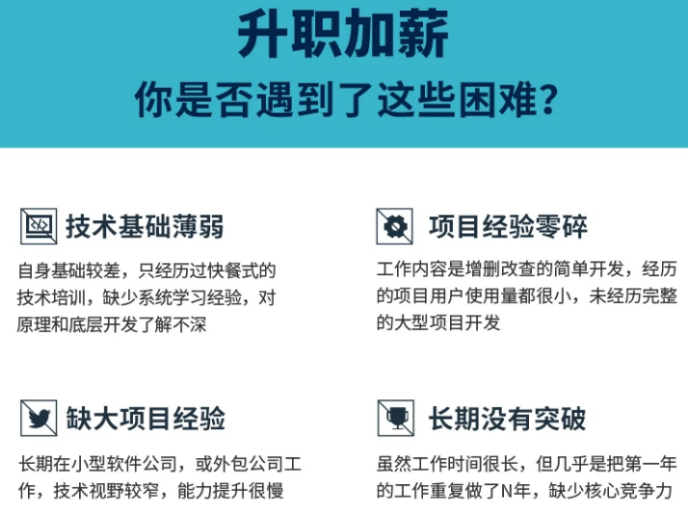
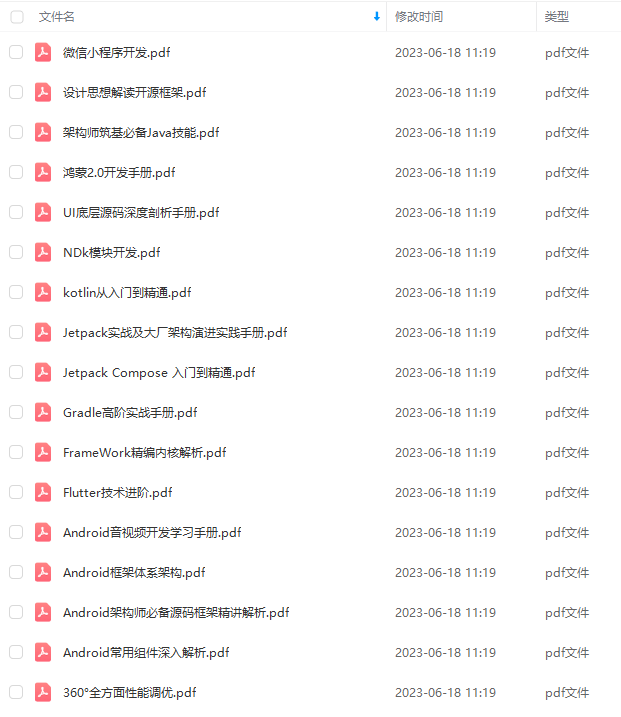
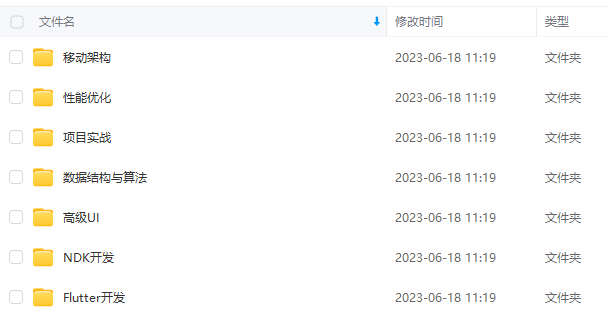

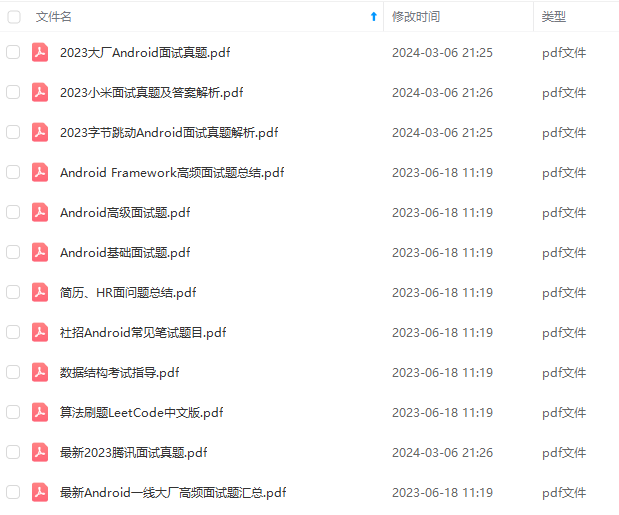
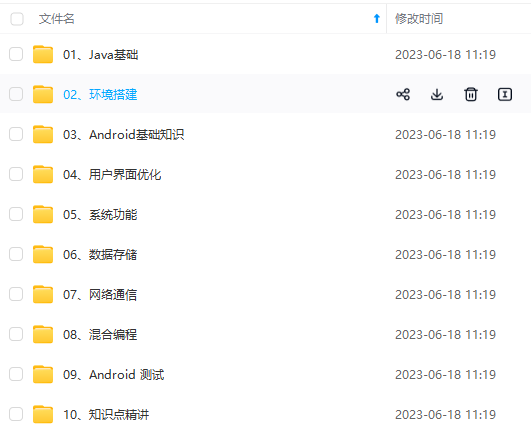
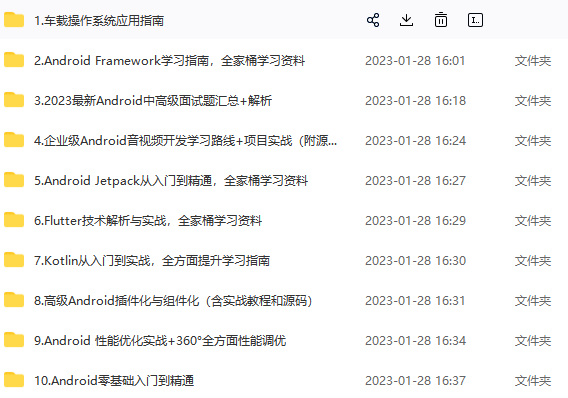
既有适合小白学习的零基础资料,也有适合3年以上经验的小伙伴深入学习提升的进阶课程,基本涵盖了95%以上Android开发知识点,真正体系化!
由于文件比较大,这里只是将部分目录大纲截图出来,每个节点里面都包含大厂面经、学习笔记、源码讲义、实战项目、讲解视频,并且后续会持续更新
如果你觉得这些内容对你有帮助,可以添加V获取:vip204888 (备注Android)

题外话
我在一线互联网企业工作十余年里,指导过不少同行后辈。帮助很多人得到了学习和成长。
我意识到有很多经验和知识值得分享给大家,也可以通过我们的能力和经验解答大家在IT学习中的很多困惑,所以在工作繁忙的情况下还是坚持各种整理和分享。但苦于知识传播途径有限,很多程序员朋友无法获得正确的资料得到学习提升,故此将并将重要的Android进阶资料包括自定义view、性能优化、MVC与MVP与MVVM三大框架的区别、NDK技术、阿里面试题精编汇总、常见源码分析等学习资料。
【Android思维脑图(技能树)】
知识不体系?这里还有整理出来的Android进阶学习的思维脑图,给大家参考一个方向。
希望我能够用我的力量帮助更多迷茫、困惑的朋友们,帮助大家在IT道路上学习和发展~
导过不少同行后辈。帮助很多人得到了学习和成长。
我意识到有很多经验和知识值得分享给大家,也可以通过我们的能力和经验解答大家在IT学习中的很多困惑,所以在工作繁忙的情况下还是坚持各种整理和分享。但苦于知识传播途径有限,很多程序员朋友无法获得正确的资料得到学习提升,故此将并将重要的Android进阶资料包括自定义view、性能优化、MVC与MVP与MVVM三大框架的区别、NDK技术、阿里面试题精编汇总、常见源码分析等学习资料。
【Android思维脑图(技能树)】
知识不体系?这里还有整理出来的Android进阶学习的思维脑图,给大家参考一个方向。
[外链图片转存中…(img-YmHsyoHw-1711909402042)]
希望我能够用我的力量帮助更多迷茫、困惑的朋友们,帮助大家在IT道路上学习和发展~






















 4484
4484











 被折叠的 条评论
为什么被折叠?
被折叠的 条评论
为什么被折叠?








